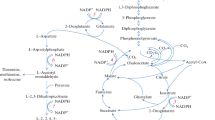Abstract
Eight uracil-dependent mutants ofBrevibacterium ammoniagenes CCEB 364 and three mutants ofCorynebacterium sp. 9366 were checked for the production of precursors of nucleic acids. Four of the strains liberated into the medium a substantial amount of orotic acid. The production of orotic acid by a mutant ofBrevibacterium ammoniagenes (1043) was examined on mineral media containing varying amounts of glucose in the presence of uracil. The optimum concentration of glucose for the production of orotic acid was found to be 5–8%. On media to which natural substrates were added the orotic acid production increased substantially. The maximum production (6.5 g orotic acid/liter) was reached in a medium containing 0.5% yeast extract and 5% glucose; addition of uracil to this medium had no effect on the production. The maximum rate of production occurred between 24 and 72 h of fermentation. After this period the concentration of orotic acid in the medium decreases.
Similar content being viewed by others
References
Beckwith, J. R., Pardee, A. B., Austrian, R., Jacob, F.:Coordination of the synthesis of the enzymes in the pyrimidine pathway of Escherichia coli. J. mol. Biol. 5: 618, 1962.
Fujimoto, M., Uchida, K., Suzuki, M., Yoshino, H.:Accumulation of xanthosine by auxotrophic mutants of Bacillus subtilis. Agr. Biol. Chem. 50: 605, 1966.
Honzová, H., Javůrková, B., Škoda, J., Dyr, J.:A quantitative evaluation of the mutagenic effect of ethylmethansulphonate in Brevibacterium ammoniagenes and qualitative character of the mutants obtained. Fol. microbiol. 13: 125, 1968.
Matthies, H., Lietz, W.:Die Bedeutung von Applikationsart und Applikationsdauer für die Wirkung von Orotsäure auf ein einfaches Model eines Lernvorganges. Acta biol. med. german. 19: 1053, 1967.
Nagano, J., Samejima, H., Kinoshita, S.:Conversion of orotic acid to uridine-5′-monophosphate by enzymes of Micrococcus glutamicus. Agr. Biol. Chem. 30: 83, 1966.
Nara, T., Misawa, M., Kinoshita, S.:Production of nucleic acid-related substances by fermentative processes. III. Fermentative production of 5′-inosinic acid by an adenine auxotroph of Brevibacterium ammoniagenes. Agr. Biol. Chem. 31: 1351, 1967.
Pynadath, T. J., Fink, R. M.:Enzymic preparation of radioactive orotidine-5′-phosphate. Biochim. biophys. Acta, 95: 355, 1965.
Schwietzer, C.:Lokalisation des Stoffwechsels der Orotsäure in der Zelle. Biochem. Z. 328: 291, 1957.
Sobek, V., Král, Z.:A salt of orotic acid and neomycin. Arzneimittel-Forschg. 17: 711, 1967.
Škoda, J., Hess, V. F., Šorm, F.:The biosynthesis of 6-azauracil-riboside by Escherichia coli growing in the presence of 6-azauracil. Experientia 13: 150, 1957.
Tada, K., Akabane, J., Yokoyama, M.: Tohoku J. exp. Med. 77: 400, 1962 (cited by Rommel, K.:Wirkungen und Nebenwirkungen der Orotsäure. Die medizinische Welt 196: 1220, 1966.
British patent 922 359, 1963.
US patent 3 686 917, 1963.
West German patent 1 197 423, 1963.
Author information
Authors and Affiliations
Rights and permissions
About this article
Cite this article
Škodová, H., Šolínová, H., Škoda, J. et al. The capacity of orotic acid production in pyrimidinedeficient mutants ofBrevibacterium ammoniagenes . Folia Microbiol 14, 145–154 (1969). https://doi.org/10.1007/BF02892884
Received:
Issue Date:
DOI: https://doi.org/10.1007/BF02892884



